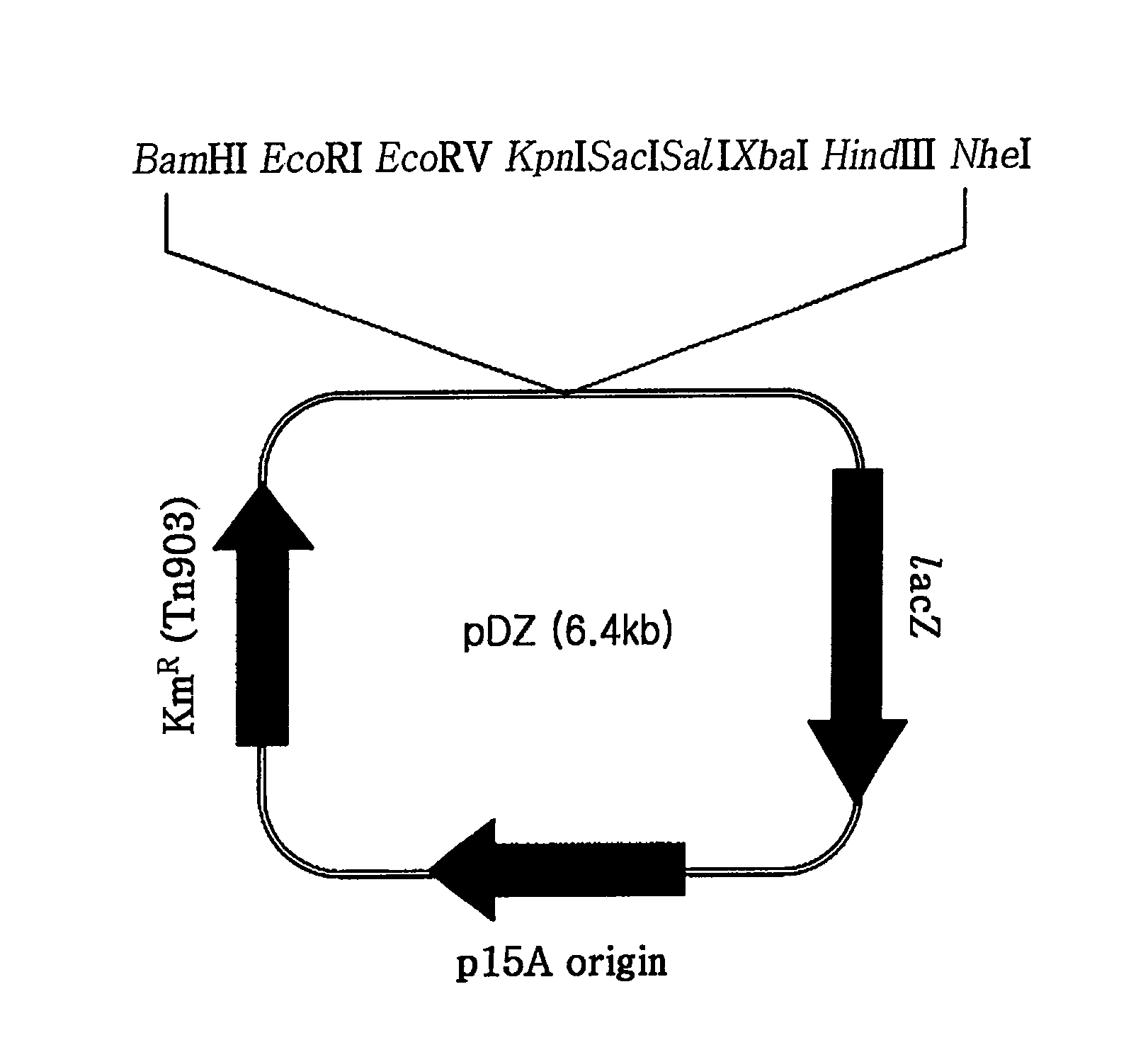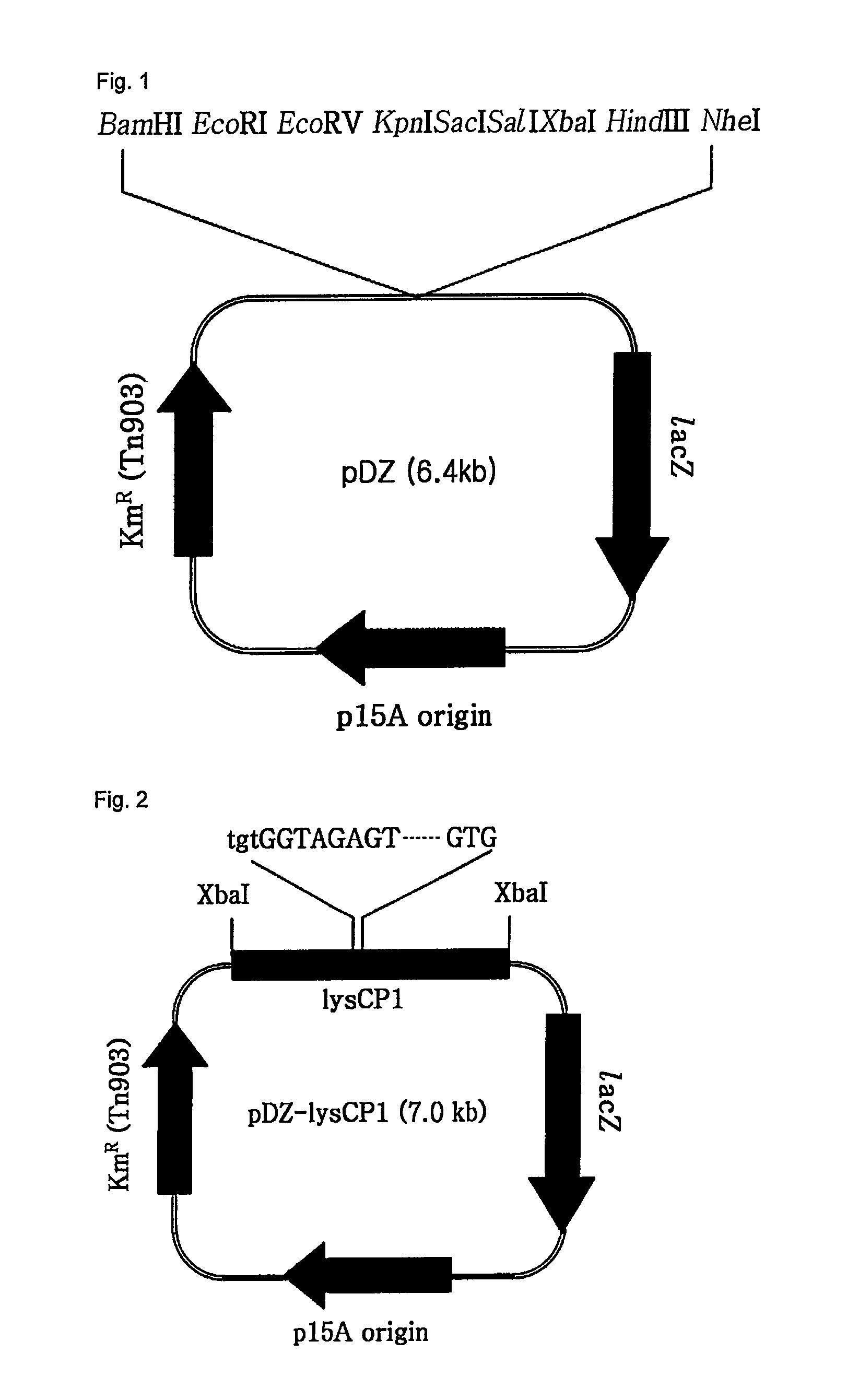Promoter and a production method for L-lysine using the same
a technology of promoter and lysine, which is applied in the direction of enzymology, organic chemistry, transferases, etc., can solve the problems of no coryneform bacteria which are improved in the activity of lysc, and achieve the effects of improving promoter activity, increasing promoter activity, and increasing the levels of aspartate kinase and aspartate semialdehyde dehydrogenas
- Summary
- Abstract
- Description
- Claims
- Application Information
AI Technical Summary
Benefits of technology
Problems solved by technology
Method used
Image
Examples
example 1
Construction of Recombinant Vector Containing Improved Promoter
[0046](1) Construction of a Vector for Integration into Genome (pDZ)
[0047]In this example, pDZ, a vector to be integrated into Corynebacterium genome, was constructed on the basis of pACYC177 (New England Biolab, GenBank accession # X06402), a vector for use in E. coli.
[0048]After being treated with AcuI and BanI, the pACYC177 vector was blunt ended with a Klenow fragment. For the use as a selection marker, a lacZ gene originating from E. coli was prepared by amplifying a genomic DNA of E. coli K12 W3110 comprising the gene and its promoter through PCR, followed by treating the PCR product with T4 DNA polymerase and polynucleotide kinase to phosphorylate at 5′ end and make the opposite ends blunt, respectively. The two DNA fragments thus obtained were ligated to each other to give a circular Nucleic acid molecule into which an artificially synthesized adaptor sequence containing a plurality of restriction enzyme sites w...
example 2
Introduction of the Recombinant Vector into Corynebacterium glutamicum Strain
[0056]In this example, the recombinant vector prepared above was introduced into the lysine-producing strain Corynebacterium glutamicum KFCC-10881, so that the modified ddh promoter sequence on the vector was integrated into the genome of the cell through homologous recombination with the endogenous promoter of the lysC-asd operon on the genome.
[0057]To this end, the recombinant vector pDZ-lysCP1 containing the DNA fragment corresponding to the modified promoter sequence was transformed into Corynebacterium glutamicum KFCC10881 using an electroporation method (based on Appl. Microbiol. Biotechnol. (1999) 52:541-545), followed by selecting on a selection medium containing kanamycin in an amount of 25 mg / L the transformants in which the modified promoter was integrated into the genome through homologous recombination with the endogenous promoter.
[0058]Success in the insertion of the vector into the genome was...
example 3
Assay of the lysC-asd Promoter-Improved Strain for Aspartate kinase Activity
[0060]The mother strain Corynebacterium glutamicum KFCC10881 and the L-lysine-producing strain Corynebacterium glutamicum KFCC10881-lysCP1 finally prepared in Example 2 were cultured, and proteins were isolated from the cultures and assayed for aspartate kinase activity, as follows.
[0061]Each of the cultures grown to the logarithm phase was inoculated into 50 mL of the following seed medium to give an OD600 of 0.3, and then incubated until the optical density at 600 nm reached about 15. After being collected through centrifugation (5,000 rpm, 15 min), cell mass was washed twice with 0.1% Tris HCl (pH 8.0) and suspended in the same buffer to an optical absorbance at 610 nm of turbidity 160. Cells were disrupted for 6 min in a glass beater with glass beads added at 1.25 g / 1.5 ml of the suspension. After centrifugation (15,000 rpm, 20 min), the supernatant was quantitatively measured for protein content by a Br...
PUM
| Property | Measurement | Unit |
|---|---|---|
| temperature | aaaaa | aaaaa |
| temperature | aaaaa | aaaaa |
| temperature | aaaaa | aaaaa |
Abstract
Description
Claims
Application Information
 Login to View More
Login to View More - R&D
- Intellectual Property
- Life Sciences
- Materials
- Tech Scout
- Unparalleled Data Quality
- Higher Quality Content
- 60% Fewer Hallucinations
Browse by: Latest US Patents, China's latest patents, Technical Efficacy Thesaurus, Application Domain, Technology Topic, Popular Technical Reports.
© 2025 PatSnap. All rights reserved.Legal|Privacy policy|Modern Slavery Act Transparency Statement|Sitemap|About US| Contact US: help@patsnap.com


